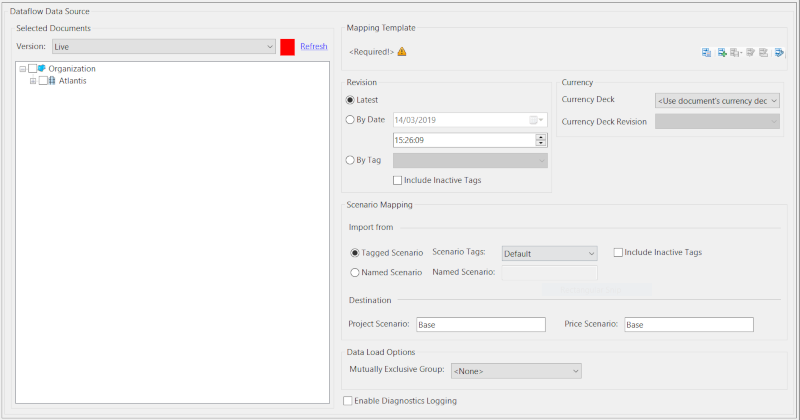Dataflow loading screen
This screen opens when you add a Dataflow data source. For instructions on how to load data, see Load data from Dataflow. All fields are described in the table below.
Connection is made automatically to Dataflow in the same tenant where you are running Portfolio.

| Field | Description |
|---|---|
| Selected Documents | Select the version of the Dataflow hierarchy and the documents you want to load. |
| Mapping Template | Select or create a mapping template (buttons are described below); for instructions, see Dataflow mapping template. The name of the currently selected template and the time when it was applied are shown on the left-hand side. |
| Revision | Select the document revision to be loaded. You can load the latest revision, or choose a specific one based on tags or date and time. |
| Currency | Select the currency deck and its revision for loaded Dataflow documents. |
| Import From | Select Tagged Scenario to import from a document scenario with a particular tag; this would only import documents that have a scenario tagged with selected tag. To import from a document scenario with a particular name, select the Named Scenario option and enter the name in the text box. |
| Destination | Select or enter project and price scenarios for use in Portfolio. |
| Mutually Exclusive Group | Determines the field by which projects will be grouped when data is loaded and optimization takes place. For more information, see Mutually Exclusive Groups. |
The table below describes the template management buttons.
| Button | Function |
|---|---|

|
Opens the list of existing templates where you can select a template to be used for import. |

|
Creates a new template. |

|
Saves the currently selected template on your computer. If you click the arrow, you can choose to replace an existing template, or to save under a different name. |

|
Opens a window where you can edit the currently selected template. |

|
Renames the selected template. |

|
Opens a window where you can manage existing templates (see Manage mapping templates). |
